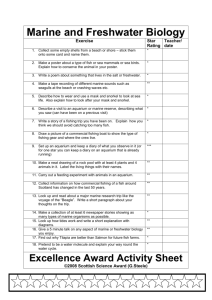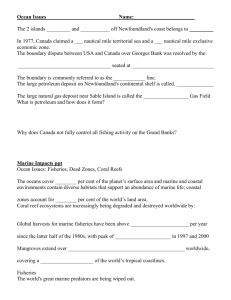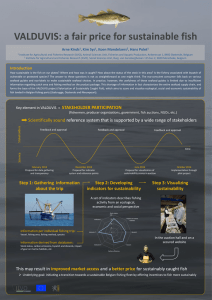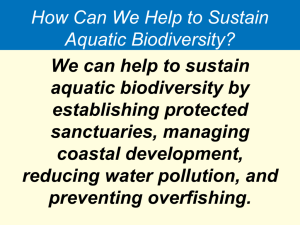Turning the Tide Prepared by the Steering Committee for Changing Currents
advertisement
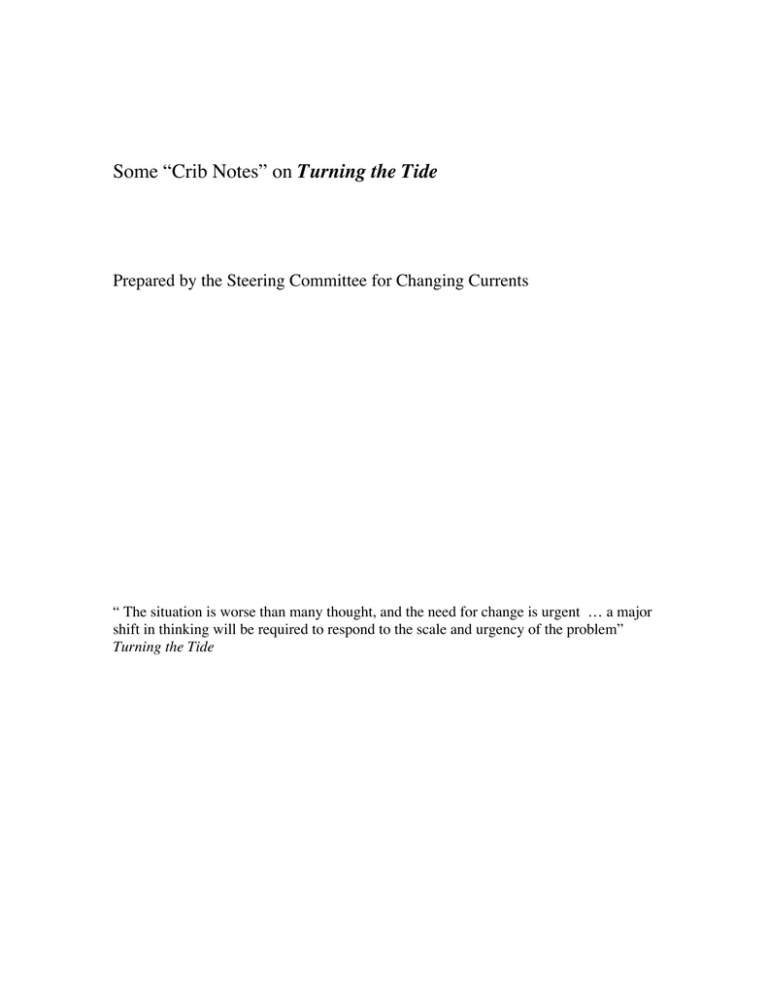
Some “Crib Notes” on Turning the Tide Prepared by the Steering Committee for Changing Currents “ The situation is worse than many thought, and the need for change is urgent … a major shift in thinking will be required to respond to the scale and urgency of the problem” Turning the Tide Key Issues Decline in fish stocks • “The fact that the ecosystem has become impoverished will be lost on each new generation of fisheries scientists and historical accounts of former abundance will be ignored or discounted as methodologically naïve – attempts will only be made to maintain the ecosystem at this level” • Rate of decline shows situation is not only disastrous but rapidly moving to catastrophe • Global problem, not just the North Atlantic • Overfishing provoking widespread changes to coastal and ocean ecosystems • Damage entire ecosystems by disrupting food webs and changing multi-species population dynamics • Studies of fishing impacts may under-estimate the extent of changes because analyses are based on datasets that began after the onset of exploitation – and knowledge of the structure of unexploited fish communities is usually lacking • Fish are smaller and change in type of fish • Declines in many fisheries offset by exploiting new species including deepsea fish • Increasing portion of capture fisheries used to feed carnivorous farmed fish • Estimates of spawning biomass of various species have generally failed to characterize adequately the real uncertainty in future stock sizes • Most marine fish species not resilient to large population reductions • Models used to assess population sizes do not take account of evolutionary and ecological effects of fishing pressure on marine organisms in affected ecosystems, nor their basic biological responses e.g. habitat preference, mating behaviour • Long-lived fish with low natural mortality have been removed from marine ecosystems and replaced by short-lived species with more volatile population dynamics • Consistent decline in mean trophic level of global landings • Alterations in non-target populations of fish and benthos • Changes in structure and species composition of fish communities • Size shift within and across species • Changes in size structure of target populations • Altered predator-prey relationships • Alteration of physical environment through seabed disturbance • Alterations in chemical environment • Additional fishing power is generated in response to population depletion to maintain catches, by investment through loans or subsidies leading to fleet overcapacity and further population depletion. Reduction in biodiversity • Clear link between fishing and reductions in biodiversity 2 • Loss of resilience in system, likely to be compounded by effects of climate change • Loss of diversity reduces future capacity to adapt to changing environment • Conservation status of less than 5% of fish species has been assessed to the Red List of Threatened Species Fisheries - Fisheries Management • Need to predict structure of ecosystems under present climatic influences if they were not impacted by fishing to determine impact of fishing on the structure of marine ecosystems • On paper, system appears to build requirements for environmental assessment – in practice these are weak and can be circumvented • Management schemes usually implemented well after commercial fishing has begun and at best only serve to stabilise fish biomass at low levels • Policy goal of sustainable yields at close to maximum leveldamaging to both fish populations and marine ecosystems • Regulatory measures tend to view fish as stocks to be managed to deliver a maximum sustainable yield rather than as populations to be protected as part of a complex ecosystem • Fishery policies have failed even in terms of their own narrow objectives • Catch controls do not reflect the interaction between species that is crucial for long-term sustainability of commercial species • Fishery regulations largely manage maxiumum sustainable yield of particular species of fish (despite move to ecosystem approach) • Political process of translating suggested limits into quotas has meant scientific advice and numbers attached to estimates of sustainable yield have seldom been heeded • TACs set well above scientifically advised levels • TACs are inappropriate management tool for mixed demersal fisheries and deep-water species • Little quantifiable information on environmental impact of technological advances • Technological development has contributed to overall increase in environmental impact by increasing temporal and spatial fishing effort • Ghost fishing - shift from biodegradable materials in nets to polymer-based fibres that allow bigger nets and persist in environment when lost or abandoned • Malpractice such as overstating reported catch in order to retain historic quota • Catch controls encourage high grading and discarding • Inspections are anticipated and illegal catch hidden • Fines for illegal fishing are inadequate • Access agreements transfer fishing pressure to other waters (eg allow EU boats to out-compete local fishers) - Bycatch and discards 3 • Discards rarely survive - a large waste of resources that can have severe ecological impacts • True level of fishing activity hard to estimate • Because majority of fish species are not managed, local extinctions of marine fishes and invertebrates as a result of bycatch tend to be overlooked until long after they have occurred. - Bottom trawling • Modifies and removes habitats that support diverse communities • Modifies diversity, community structure, trophic structure and productivity of macrobenthic invertebrate communities • Scrapes and ploughs seabed, reducing diversity of benthic communities • Inflicts unsustainable rates of mortality on species with slow rates of population increase • Disrupts and resuspends sediment and affects biogeochemical cycling • Source of chronic and widespread disturbance in shallow seas • Modifies communities to resilience of dominance by resilient species • Effects are most significant in areas of relatively low natural disturbance and on structurally complex and delicate biogenic habitats (eg coldwater coral reefs - Seamounts • Risk of severe depletion of elements of benthic seamount fauna is increased by their highly specific habitat requirements, localized distributions and high levels of local endemism • Trawl fishery gear has caused damage to the vulnerable and unique animals living on seamounts – damage may be irreparable on human time-scales - High seas • ‘State of freedom’ as unregulated common resource • Almost all fish caught by bottom trawling on high seas are straddling stocks • Few regulations concerning bottom trawling impact on biodiversity of high seas • Nearly all species targeted in demersal fisheries have become depleted • Populations are often exploited before information is available on the biology and productivity of the species present, before time series data are available for assessments, and before evaluation of potential impacts of fishing on the environment can be made • Industry is small and concentrated in a few hands but environmental impact is significant and widely dispersed • High rates of bycatch • Discarding deepwater fish always results in their death due to pressure differences • Quota schemes and effort controls are unlikely to control deep-sea fisheries adequately - because fishing pressure can deplete fish populations faster than control measures can take effect • “there is no such thing as an economically viable deep-water fishery that is also sustainable” - Subsidies • Difficult to trace subsidies to fishing industry and calculate total amounts (due in part to large variety of direct and indirect fisheries subsidies) 4 Economic Issues • Fishing comprises only a small part of wide variety of goods, services and other benefits that the oceans and seas provide • Size of fishing industry is diminishing – most vulnerable communities are those in remote areas cut off from other sources of employment • Fishing fleet overcapacity creates strong incentives to fish illegally Aquaculture • Misunderstanding re: aquaculture; i.e., not a straight forward substitution of wild fish for farmed ones • Inadequate controls before industrial development • Types of fish farmed in temperate climates are carnivorous and depend on fishmeal for most of their diet • Environmental impacts of removing forage fish from ecosystem • In north-west Europe the aquaculture industry reliant on capture fisheries for aquafeed • Interactions between farmed species and wild populations of fish and shellfish • Potential reduction in fitness in wild population as result of both interbreeding and competition • Nutrient enrichment from faeces, uneaten food and dissolved metabolites that end up in water and sediments • Chemical pollution from chemicals used to treat disease and parasitic infections • Concerns about potential contamination of farmed fish by heavy metals and organic compounds which have been transferred up the food chain from feed • Habitat change or destruction including loss of coastal and wetland habitats, creation of dead zones on bottom of sea, riverbed or freshwater pond • For shellfish water quality, algal toxins, carrying capacity; increased sedimentation and anoxia and change in infaunal community • Visual impact on landscape Shipping/marine transport • Marine emissions from fuels used for international journeys (bunker fuels) remain outside international agreements to control greenhouse gases • By 2010 estimated ship emissions likely to equal two thirds of land emissions Marine Pollution • Land based activities including agriculture raise nutrient levels – input of nutrients from land • Industrial pollution can render seafood unfit to eat • Input of trace organic contaminants (other than oil and PAHs from land) • Input of TBT and other antifouling substances by shipping 5 Protected Areas • Area given over to conservation is vanishingly small and largely designed to protect specified areas and habitats, rather than interconnected parts of the ecosystem. • At European and UK level current legal framework for protecting marine environment is weak – areas of conservation importance are offered only very limited protection from effects of fishing Ocean use planning and governance • Current system unlikely to deliver reforms on the scale necessary • Management has concentrated on sectoral interests or single issues Climate Change • Increased CO2 is increasing acidity of ocean • Northward shift in plankton species in North Atlantic – linked to general rise in temperature in northern hemisphere • Likely to compound effects of loss of biodiversity Solutions/Recommendations/Actions General • Put much greater emphasis on protecting the marine environment • The requirement for sound science as the basis for environmental policy should not be interpreted as a requirement for absolute knowledge • For implementation, need to clarify at what spatial scale they will operate at, the depth of understanding of the natural functional limits of ecosystems required and how the effects of environmental change will be dealt with • Government must engage directly with the public, fishing industry and broad base of interested stakeholders in the debate over how the seas are managed in future Fisheries management • Determine evolutionary consequences of exploitation • Need to define precaution in an operational sense • Develop a system of ecosystem indicators for management and procedures to monitor state of marine biodiversity and impacts of human activities • Reverse the presumption in favour of fishing approach – applicants for fishing (or aquaculture) should have to demonstrate that the effects of their activity would not harm the seas’ long-term environmental sustainability • Reverse the burden of justification in capture fisheries • Priorities of fisheries managers must change to that of protecting the resource in the long term rather than protecting economic gain in the short term • Separate fishery management and allocation decisions • Use renewable fishing licences to regulate fisheries by linking licensing to marine spatial plans, reductions in fishing effort, gear restrictions and improvement in vessel monitoring technology 6 • Require a robust new system of regulation that involves not simply a new raft of regulations but a shift in the basic nature of the system from maximizing output from fish stocks to reducing to acceptable levels the harm fisheries do to the marine environment • Manage fisheries in relation to concentrations of juvenile fish (eg Norway) • Match capacity of the fishing fleet to level that can be sustained in the mediumto long term • Limit fishing effort through allocation of special fishing permits stating terms of access, time and specific fisheries • Regionalize the management through Regional Advisory Councils - example Common Fisheries Policy – sets policy at community level and thus limits extent to which member states can develop their own fishery measure - operations • Performance targets need to be set against a continuously moving baseline • Need to evolve some form of tenure or ownership • Effort controls instead of catch controls (limits number of boats or fishers who work in the industry and the time the gear can be left in the water; may also limit power or size of the vessels and periods that they can fish • Governments should rank impacts of gear specific to fisheries in relation to their impact on habitats • Better targeted technology • Retrieval programs for lost;/abandoned gear • Biodegradable release mechanisms on fish traps/pots • Return to traditional biodegradable net materials - subsidies • End all subsidies that can result in increased fishing pressure including vessel modernization, and improving port and fish processing facilities • Use subsidies to reduce fishing capacity, adopt selective and environmentally friendly fishing gear and provid information necessary for sound fisheries management • Retain subsidies to encourage diversification and environmental schemes - enforcement • More intense enforcement not the answer; a different approach which is more easily enforced is necessary • VMS, onboard satellite tracking • Use of electronic logbooks and tagging/marking of fishing gears • Strategic placing of sensors onboard vessels and fishing gears – link to VMS system - bycatch and discards • Redirect discards and bycatch from food grade fisheries to generate fishmeal • Implement technical and area-based measure to reduce by catch • More comprehensive monitoring regime to ensure compliance and determine effectiveness of measure to reduce by catch • If target levels of bycatch reduction are not met in a particular fishery, then the fishery should be closed • Discard bans provide powerful incentives for developing and using more selective fishing methods 7 - deep-sea fisheries • Governments should halt any deep-sea trawling • Ban bottom-trawling gillnetting and long-lining for deep-sea species Economic incentives • Non-monetary valuation • Funding to promote economic diversification in fisheries dependent areas • Investment aids to assist small-scale operations to increase viability and reduce dependence on commodity output • Payments to promote and facilitate collective management • Targeted research and investment in areas most likely to reduce uncertainties in a cost-effective way • Charges for licences for certain fishing practices which have an adverse environmental footprint • Payments for carrying out new duties such as monitoring non-target species or policy closed or restricted areas • Funding should be made available to help the fishing industry with the transition during establishment of MPAs - labelling • Labeling, standards and consumer information schemes need to be based on sound standards and reliably enforced and audited • Work with producers, retailers and caterers to produce a strategy that will: increase proportion of seafood and aquaculture products produced under environmentally accredited schemes; improve quantity and quality of environmental information available to consumer through labeling and awareness schemes in the retail and catering sectors; ensure the reliability to such schemes by developing appropriate standards and auditing procedures Ocean-Use Planning/Marine Use Planning • Use spatial marine planning • Human activities within the marine environment will need to be managed at the appropriate scale • Introduce new process of marine planning and strategic environmental assessment • Regional management system with decision-making powers with safeguards to ensure: proper account of scientific advice; balance range of stakeholders; clear mandate to protect environment and manage fisheries for long-term sustainability; established on a regional seas scale; independent oversight and subject to an early review of its scope success and environmental impact - Integrated Management and Ecosystem Approach • Suite of single-species indicators or single-factor indices for major target species, by-catch species, indicator species and other vulnerable species would be more pragmatic approach than attempting to develop ecosystem level indicators • Widen the group of stakeholders in the marine environment to include those without an extractive interest 8 Aquaculture •Use exclusion zones to protect wild stocks • Environmental impact assessment before application or renewal of application is granted • Seabed sediment and habitat mapping to assist in predicting consequences of locating farms in a specific area • Better understanding of carrying and assimilative capacities of coastal waters for shellfish farming • Regular monitoring • Improve efficiency and design aquaculture diets to reduce the reliance on industrially caught forage fish • Tax or other economic instrument on use of fishmeal and fish oil • Biotechnology, cultured microalgae and microorganisms to produce high quality proteins for feed • Switch to farm herbivorous species • Increase efficiency with which fishmeal and fish oil are used within the aquaculture industry • Encourage trend away from use of fishmeal and fish oil in the livestock industry • Improved technical and operational standards to reduce escapes • Sterilization of farmed fish • Indicators that describe pollutant load from fish farms; performance should be monitored and published Shipping/marine transport • Bring marine emissions of greenhouse gases within international agreements and control other atmospheric emissions from ships Institution and governance • Develop institutional arrangements to bring together science and technology to inform the development of regional seas management plans • Support integrated multidisciplinary research Communication and education • Engage the public – future generations have a stake in preserving a properly functioning ecosystems • Promote a wider debate on the management of the seas • Energize public interest and debate with a clear purpose in mind • Use an inclusive approach to developing better policies • Establish a process that will provide an opportunity for a broad cross-section of the public and civil society to engage in informed debate about the management of human activity in the marine environment • Use more participatory forms of dialogue that focus on helping to articulate public values at an early stage in the policy process • Use this process to inform the development of new policies 9 • Develop and implement strategies for: improving education on marine matters by including issues in to key stages of the national curriculum; communicate marine issues to stakeholders and the public • Transfer knowledge about environmental impacts of marine capture fisheries to policymakers, regulators, fisheries managers and others Integrate and improve existing information • Use regional sea framework and marine landscapes for development and implementation of strategic and spatial planning in the marine environment • Encourage government and other institutions to fund new and exciting research to help us understand the marine environment and develop better more sensitive ways of managing our impact on it • Classification of marine landscapes can be used to predict the susceptibility of their biological communities to human impacts and also to identify areas of national importance, rare habitats and areas necessary to sustain rare species • Census of Marine Life approach – global network of researchers - goal to assess and explain the diversity, distribution and abundance of marine life – past present and future • Government should encourage universities, research councils and others to fund research on the marine environment and consider ways of improving the dissemination and use of marine data • Potential for fishers to collect data in a systematic way • Develop methods for including fishers’ knowledge in fisheries assessment processes • Put in place fisheries subsidies to support research and monitoring schemes that use information provided by fishers in order to supply data for modeling and management • Need continued gathering monitoring and synthesizing of data • Information from ecosystem models will contribute to the decision-making process but not replace it • Design a set of indicators to assess fishing activity against ecosystem targets Protected Areas • One of the most simple and straightforward means for implementing ecosystem approach • Insurance should other management measures go wrong • Can provide a critical benchmark for evaluating impacts and threats to ocean communities • Do not require comprehensive understanding of individual sites before they are designated • Can achieve same level of control over catches of target species as traditional effort control • Benefits in addition to fishing – tourism, recreation opportunities, protection of wider ecosystem services • Can be simpler to establish and enforce than some current fishery measures 10 • Considerable scientific consensus that benefits are much increased if areas are linked together into coherent networks • Substantial benefits can build up quickly • Consistent increase in biomass in marine reserves - inside reserves adult fish populations are larger, longer-lived and more fecund than in fished areas • And spillover effects • Provide important scientific information about what a natural ecosystem might look like • Needs to be careful choice of ecological and other crieteria used and performance of established reserves must be monitored • Designation of Particularly Sensitive Sea Area • Significant economies of scale for larger MPAs • Develop comprehensive plan to manage and protect priority coastal wetlands Successes • Protection of Darwin mounds – cold water reefs off north-west Scotland • Invest in Fish South West – long-term strategy for managing fishing fleets on a regional basis, taking important local factors into account • Marine protection plan for the Great Barrier Reef Marine Park • ‘Closed’ areas on Georges Bank and southern New England – best documented examples of temperate reserves • Wadden Sea – example of large-scale integrated management • Loch Torridon creel fishery • Solway Firth Partnership shellfish management plan • Canada’s Oceans Act and Australia’s Oceans Policy Major Knowledge Gaps • Change emphasis of research away from management of fish populations towards a wider focus on the marine environment • Field studies on poorly known habitats • Understanding of mechanisms responsible for creation, maintenance, and regulation of habitat-specific marine biodiversity (inadequate knowledge of species present in given marine ecosystem limits understanding of how ecosystems function and the prediction of how human activities impact that function. • Techniques for measuring uncertainties • Need to understand the environmental consequences of nutritional strategies and to speed up the search for alternative sources of these compounds • Knowledge of bottom fishing disturbance in shelf seas on sediment community function, carbon remineralisation and biogeochemical fluxes • Biological diversity and vulnerability to exploitation of seamount species and habitats • Knowledge of deep-sea species and habitats 11 Big Ideas • Irish Sea Pilot project – case study to develop a strategy for marine conservation – test concept of marine landscapes • A system of Marine Spatial Planning – a spatial vision for UK waters that sets out the top-level objective for management of the seas, principles that should guide its use, and how the demands of different sectors should be integrated – a comprehensive, statutory planning system that : sets out the principles and longterm goals for protecting the marine environment and promotes sustainable use of the sea; develops integrated regional management plans; has a statuatory basis and a clear framework for public participation • Implement through a Marine or Oceans Act 12


